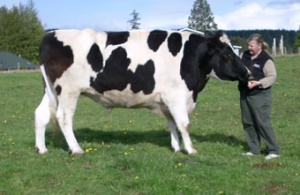Personal tools
Help
Tools
Class Notes
- Do you have news for fellow WSU alumni and other readers of Washington State Magazine? Send us your class note.
Our Story
written by alumni, faculty and friends.
NOTE: THIS IS A LEGACY SITE AND IS NOT REGULARLY MAINTAINED
Views
Difference between revisions of "Livestock advisors celebrate 20 years"
From Our Story
m |
m (Protected "Livestock advisors celebrate 20 years": wsm article [edit=author:move=author]) |
(No difference)
| |
Revision as of 16:59, April 13, 2009
By Dennis Brown
From Washington State Magazine, Winter 2004/05
The early 1980s saw a growing a back-to-the-land movement in western Washington, says Mike Hackett (’76 M.S. An. Sci.), who at the time was a limited-resources farming agent in Snohomish County.
“But nobody was getting help,” he says. “So from 1980 to about 1982, it seemed like all I was doing was answering the phone or making farm visits. I was overwhelmed with questions.”
As it turned out, the answer to his problem sat in the office next door.
“The horticulture agent was running the Master Gardener program. He was training these volunteers who went out to teach others how to raise gardens and orchards and how to care for their lawns. I thought, why can’t we do this with livestock?”
With the help of a student intern from WSU, Hackett recruited his first class of volunteers in 1983.
“Probably three out of the 10 were 4-H leaders I knew already,” he says. “Another three or four were successful farmers I knew.”
Since then, between 700 and 800 volunteers have been trained to provide advice to thousands of small-scale farmers in western Washington on topics ranging from controlled grazing methods to how to raise a small flock of chickens.
Participants trade time for training. In exchange for 80 hours of training on various livestock topics, participants agree to volunteer 80 hours of their time answering questions from the public, visiting farms, and working with 4-H-ers.
Extension faculty teach units on sheep, swine, horses, rabbits, poultry, exotics such as llamas, pasture management, and farmsteads.
Volunteers are motivated to take training for a variety of reasons.
“I’d say the very first reason is to learn for their own benefit,” says Hackett. “The second reason, and it could be the first for many, is that they want to help other people succeed.”
The people asking for help typically own 10 to 25 acres. Over the years the Extension Livestock Advisor program has evolved to respond to increased interest in organic and sustainable agriculture. More people also are interested in adding value to what they raise.“It’s a part-time income or a subsistence farm,” Hackett says. “In some cases it’s a family hobby farm. For the most part they are in it to make money.”
Hackett and colleagues in Extension estimate that about 18,000 farm families on the west side of the state fit these characteristics.
Hackett has been chair of the Skagit County extension office in Mount Vernon since 1996. For more information on the WSU Extension Livestock Advisor volunteer program, visit www.skagit.wsu.edu.
Our Story site map
Our Story main page | Our Story categories | Help Desk
Contact | Give | Advertise
Washington State Magazine | Washington State University | Class Notes
Our Story is coordinated by
In partnership with
Our Story and Washington State Magazine are publications of Washington State University. All rights reserved.
P.O. Box 641227, Washington State University, Pullman, WA 99164-1227 USA | wsm@wsu.edu, 509-335-2388
Accessibility | Copyright | Policies


